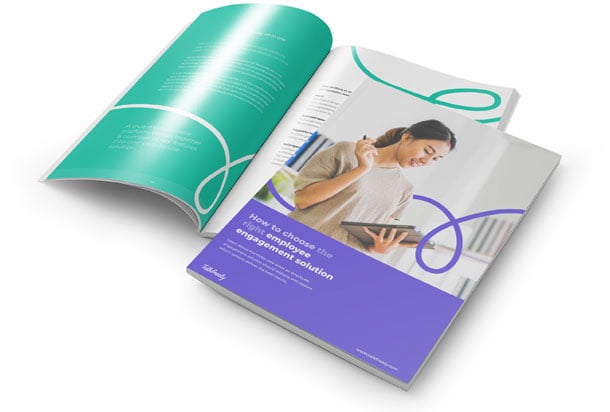Let’s talk… Easier said than done in the modern workplace. We all know that communication is important, but it can be a challenge to implement in today’s business landscape. And, the rise of hybrid and remote working isn’t making our lives any easier. But, effective communication in the workplace can transform the productivity of individuals, teams and businesses. Get it right, and you’re on the path to success.
The workplace has transformed over the last few years, and businesses have had to adapt their internal communications accordingly. But as we settle into new working patterns, it has become clear just how crucial effective business communication really is. There is an increasing need to effectively transmit the goals, values and practices of your organisation in a way that inspires action and results. And it’s also clear that how you communicate information is just as important as the information itself.
In this blog, we identify the eight golden rules of effective communication strategies in the workplace. These internal communication best practices will help you implement a strategy that works, giving you a team that is connected, engaged and motivated in any situation. And ultimately, a team that delivers to target. New business landscape or not, that’s what effective communication in the workplace is all about.
Golden Rule #1: Avoid Communication Overload
Send the right message to the right people at the right time. No more, no less.
Less is more. Keep that concept in your head at all times. In this age of information overload, where inboxes are straining, phones are ringing, and direct messages are constantly pinging, your employees are already pushed to the limit. And our workloads are increasing with each passing year. You can’t expect employees to take time out to read a 10-page report on the latest business successes or a complex guide to the new file-sharing system.
This information overload is negatively affecting employees’ health and well-being. In fact, according to recent research, 25 per cent of workers experienced significant stress and poor health due to the volume of information they’re required to process. The importance of effective email communication in the workplace becomes apparent when you’re trying to cut through the noise, and get your message heard.
The solution to information overload
Keep your communications simple, brief and to the point. When communicating with employees, consider whether your messages are relevant before you press ‘send’. If you ensure that the communications you send out are concise, pertinent and addressed to the correct audience, you’ll automatically gain greater traction. Consider writing a schedule into your internal communication strategy, detailing the key messages that need to be sent in the course of a business year. And then try not to add to it too much. Your employees will thank you.
Golden Rule #2: Use the Right Tools
Use internal communication tools that break down barriers, not ones that create them.
The working landscape has changed beyond recognition over the last few years, and our approach to internal communications needs to adapt. With the rise in remote and hybrid working patterns, expecting staff to battle technology issues to access the latest company news is no longer acceptable. One of the key reasons the traditional employee intranet often fails is its propensity to create barriers rather than open doors.
If you’re going to connect with every hard-to-reach employee successfully, you’ll need to take an extremely user-friendly method. When you assess your internal communication tools, it’s vital to consider whether they are using platforms that are readily accessible to all. This is at the heart of effective communication skills in the workplace. They need to reach every employee, from the office-based staff to the homeworkers, the hybrid workers who are hot-desking around the company, and those on the road.
The solution to technology barriers
Your aim is to ensure all your staff actively participate in and enjoy your internal communication channels. That’s quite a big ask. However, the simple answer is to give them what they want. An internal communications app does just that. It removes barriers by allowing employees to use their favourite means of communication, whichever hardware or software platform they prefer. You instantly get greater buy-in once you give employees the freedom of choice. It’s one of the examples of effective communication in the workplace that delivers every time.
Golden Rule #3: Encourage Collaboration
Teams and departments shouldn’t operate in isolation. Open up a social space.
What is effective communication in the workplace? It’s getting people talking. Collaboration is hard enough to promote at the best of times. But when remote and hybrid working is added into the mix, it becomes an issue that needs addressing. The ability to collaborate with co-workers is becoming more difficult as colleagues lose the common ground of the shared office space. According to a report by The Economist Intelligence Unit, this can have a powerful effect on efficiency and loyalty.
Cross-departmental communication is a key role of internal communication. Consider holding a Q&A session or organising an insight meeting between different departments to bridge the gap. This will promote learning and personal development and keep teams from feeling isolated from each other. The importance of effective communication in the workplace becomes immediately obvious as collaboration improves.
The solution to connecting remote teams
Trying to encourage conversation? An internal communications app provides a simple answer. Built-in modules offer a social space where employees can meet, chat and share. Whether you want to hold dedicated group conversations or provide a space for private discussions, it’s a great way to improve internal communication. By implementing social tools and spaces that employees enjoy using, you’ll cultivate a commitment to common business goals.
Golden Rule #4: Implement Two-Way Communication
Give employees a channel to feedback on their opinions and share ideas
What is two-way communication? Think of tennis. A great match is one where volleys are traded back and forth over the net. It’s not much of a game if it’s just won on serves alone. Similarly, effective communication in business happens when there is a dialogue that goes back and forth between the leadership team and employees. Why is effective communication important in the workplace? Because if there’s no dialogue, there’s no buy-in from your employees.
What you’re doing is creating a democratic environment where people share their thoughts and ideas, regardless of the corporate hierarchy. This not only helps you to solve problems by raising awareness of issues on the shop floor, but it also raises engagement levels. Employees need to feel they have a voice. However, it is essential to remember to act on the feedback you gather. One common internal communication mistake is collecting feedback but failing to deliver measurable outcomes.
The solution to starting a dialogue
An internal communications app will simplify collating and following up on employee feedback. Schedule regular polls or internal communication surveys to determine what your staff are really thinking. Ask about job roles, company policies and working conditions. You can also encourage innovative thinking by providing platforms for employees to put forward ideas and suggestions to current business challenges. Ideas management workflows will help to ensure that no great idea goes unnoticed.
Golden Rule #5: Focus on Mental Wellbeing
Acknowledge the importance of mental well-being at work
Since the pandemic, we have seen a sharp increase in mental health issues in the workplace and beyond. While this is definitely not a positive outcome, it has positively affected internal communication trends. We’re seeing more mental health initiatives woven into strategies that previously left this area unacknowledged. And it really highlights the importance of effective communication in the workplace.
Mental well-being has been brought to the front of the queue, with many organisations implementing trained teams and advocates to help support employees. And while companies have started doing more to protect and promote positive mental well-being among their workforce, the great news is that this trend has continued to take hold as the world returns to normality.
The solution to prioritising mental health
In order to put mental well-being at the top of the list, you need to provide a safe space for employees to be able to talk, meet and share. For this space to be accessible to all – both remote workers and office-based employees - it needs to be online. An employee app will give you a ready-made platform perfect for this purpose. By providing a safe social space for colleagues to discuss issues and concerns, you’ll be delivering just what’s needed. It’s one of the most effective communication strategies in the workplace. It shows you care, you’re listening, and you’re acting. This is what people need to know right now.
Golden Rule #6: Recognise Success
Openly acknowledge and praise achievement in the workplace
Recognition is a powerful entity. Just the smallest amount of praise can make all the difference between employees feeling appreciated or undervalued. In fact, a survey by the APA revealed that employees who feel valued report “higher levels of engagement, satisfaction, and motivation”. If you want to explain the principles of effective communication in the workplace, just point your managers to the outstanding results of recognition programmes.
Of all the internal communication ideas, implementing a praise policy is one of the most simple yet most effective. This can be as straightforward as announcing individual or departmental successes through the company newsletter or other internal communication channels. It’s even more valuable when you create opportunities for peer approval. By allowing colleagues to congratulate each other, you create a positive, team-building atmosphere.
The solution to recognising achievements
You need to create a platform for this company-wide recognition to take place. On this platform, you can celebrate success, push company values and, most importantly, thank the employees driving the business forward. An internal communications app will give you that social space, allowing peer-to-peer recognition and leadership appreciation. The importance of effective communication in the workplace is never seen more clearly than in the case of company recognition.
Golden Rule #7: Inspire Action
Communications should involve, motivate and inspire employees
What is effective communication in the workplace? Simple. You need to make sure your messages really connect with your audience. Here, the difference between operational communication and internal communication is crucial. While it is essential to convey the key information, procedures, and rules required for an employee to operate effectively, you also need to talk to them in a way that resonates. This is key for hybrid workers, who often operate away from management's eyes.
Explain the importance of effective communication in a workplace with an action-based strategy. Your internal communication strategy should include a wide variety of approaches and channels designed to reach every one of your employees. Your aim is to inspire them. Ultimately, you want them not just to read your communications; you want them to be motivated to take action. That’s the hard part. Whichever method of internal communication you choose, whether it’s call-to-action messages or company mission statements, it should always be designed to resonate with your audience.
The solution to inspire action
Your aim is to encourage staff to get involved and take action. Make sure you elicit participation by inviting responses to your messages and opening new opportunities to interact. Consider bringing in social media elements: enrich your information with real-time updates, multimedia elements and clickable links. When you want to improve internal communication, these popular features will have a powerful effect on engagement levels. The benefits of effective communication in the workplace will be instantly obvious.
Golden Rule #8: Measure Your Impact
Monitor the impact of your communications and adapt your strategy accordingly
As the founder of GoDaddy once said, “Anything that is measured and watched, improves.” This is especially relevant in the case of internal communications. Unless you know who has read your communications and what action they have taken as a result, you are operating blind. In the current business climate, with so many employees working remotely, keeping track of internal communications metrics has never been more critical.
The most successful internal communications plan will be continually adapted and updated according to the latest figures. And you can only do that if you have complete information about how your communications are being received. Effective communication in the workplace is built on facts and figures, not gut feel. This is not a time for guesswork. Effective communication strategies in the workplace need constant adjustments and tweaks to be as impactful as you require.
The solution to measuring impact
An internal communications app will give you this essential information at a glance. The built-in dashboards and in-depth reporting help you to monitor just how well, or not, your communications are performing. When you’re looking to monitor the overall health of your organisation, regular check-ups are the key to success. Relying on a one-off annual survey can skew the figures. Make sure you schedule frequent polls and surveys to give you a complete picture. This is the cornerstone for effective communication in the workplace.
In Summary: The Importance of Effective Communication in the Workplace
So, why is effective communication important in the workplace? It’s a no-brainer. It boosts employee engagement, it boosts productivity, and it boosts satisfaction. It’s a key element of team collaboration and cooperation. And, it drives better results for everyone; employees, teams and organisations. Follow these eight golden rules, and you’ll see the benefits of internal communication really come into play.
The benefits of effective communication in the workplace are both short-term and long-term. Put the right strategies in place, and you’ll feel the benefits instantly in terms of staff morale, satisfaction and understanding. Longer-term, you’ll see these benefits played out in higher productivity, reduced staff turnover and more significant profit margins. And who doesn’t want that?










